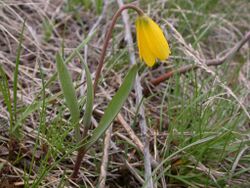Biology:Fritillaria pudica
| Yellow fritillary | |
|---|---|

| |
| Scientific classification | |
| Kingdom: | Plantae |
| Clade: | Tracheophytes |
| Clade: | Angiosperms |
| Clade: | Monocots |
| Order: | Liliales |
| Family: | Liliaceae |
| Subfamily: | Lilioideae |
| Tribe: | Lilieae |
| Genus: | Fritillaria |
| Species: | F. pudica
|
| Binomial name | |
| Fritillaria pudica (Pursh) Sprengel
| |
| Synonyms[1] | |
| |
Fritillaria pudica, the yellow fritillary, is a small perennial plant[2] found in the sagebrush country in the western United States (Idaho, Montana, Oregon, Washington (state) , Wyoming, very northern California , Nevada, northwestern Colorado, North Dakota and Utah) and Canada (Alberta and British Columbia).[3][4] It is a member of the lily family Liliaceae. Another common (but somewhat ambiguous) name is "yellow bells", since it has a bell-shaped yellow flower. It may be found in dryish, loose soil; it is amongst the first plants to flower after the snow melts, but the flower does not last very long; as the petals age, they turn a brick-red colour and begin to curl outward.[5][6][7][8][9] The flowers grow singly or in pairs on the stems, and the floral parts grow in multiples of threes.[10] The species produces a small corm, which forms corms earning the genus the nickname 'riceroot'.[10] During his historic journey, Meriwether Lewis collected a specimen while passing through Idaho in 1806.[11]
The corm can be dug up and eaten fresh or cooked; it served Native Americans as a good source of food in times past,[12] and is still eaten occasionally. Today these plants are not common, so digging and eating the corms is not encouraged. The plant is called [ˈsɨkni] in Sahaptin.
References
- ↑ The Plant List
- ↑ Barker, Joan. The Ultimate Guide To Wildflowers of North America, page 54, Parragon, 2013
- ↑ Kew World Checklist of Selected Plant Families
- ↑ Biota of North America Project
- ↑ Jepson Manual Treatment
- ↑ Flora of North America
- ↑ Sprengel, Curt Polycarp Joachim. 1825. Systema Vegetabilium, editio decima sexta 2: 64. Fritillaria pudica
- ↑ Pursh, Frederick Traugott. 1814. Flora Americae Septentrionalis 1: 228, pl. 8, as Lilium pudicum
- ↑ Gandoger, Michel 1920. Bulletin de la Société Botanique de France. Paris vol 66 as Fritillaria dichroa, Fritillaria leucella, Fritillaria oregonensis, Fritillaria oreodoxa, Fritillaria utahensis, Fritillaria washingtonensis
- ↑ 10.0 10.1 Taylor, Ronald J. (1994) (in en). Sagebrush Country: A Wildflower Sanctuary (rev. ed.). Missoula, MT: Mountain Press Pub. Co. pp. 78. ISBN 0-87842-280-3. OCLC 25708726. https://www.worldcat.org/oclc/25708726.
- ↑ Schiemann, Donald Anthony, Wildflowers of Montana, page 134. Mountain Press Publishing Company, Missoula,2005.
- ↑ Fagan, Damian (2019). Wildflowers of Oregon: A Field Guide to Over 400 Wildflowers, Trees, and Shrubs of the Coast, Cascades, and High Desert. Guilford, CT: FalconGuides. pp. 129. ISBN 978-1-4930-3633-2. OCLC 1073035766. https://www.worldcat.org/oclc/1073035766.
External links
| Wikimedia Commons has media related to Fritillaria pudica. |
Wikidata ☰ Q1645102 entry
 |

